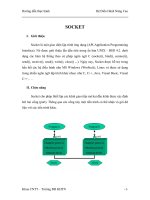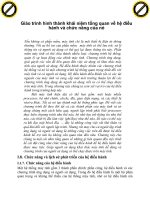Memory management (hệ điều HÀNH NÂNG CAO SLIDE)
Bạn đang xem bản rút gọn của tài liệu. Xem và tải ngay bản đầy đủ của tài liệu tại đây (721.41 KB, 70 trang )
Chapter 2. Memory Management
•
•
•
The main purpose of a computer system is to execute
programs. These programs, together with the data they
access, must be in main memory (at least partially)
during execution.
Many memory-management schemes exist, reflecting
various approaches, and the effectiveness of each
algorithm depends on the situation.
Selection of a memory-management scheme for a
system depends on many factors, especially on the
hardware design of the system.
• OBJECTIVES
– To provide a detailed description of various
ways of organizing memory hardware.
– To discuss various memory-management
techniques,
including
paging
and
segmentation.
1. Main Memory
1.1.Background
1.1.1. Basic hardware
• Main memory and the registers built into the
processor itself are the only storage that the CPU
can access directly.
• There are machine instructions that take memory
addresses as arguments, but none that take disk
addresses.
• Registers that are built into the CPU are generally
accessible within one cycle of the CPU clock.
• Most CPUs can decode instructions and perform
simple operations on register contents at the rate
of one or more operations per clock tick.
• Memory access may take many cycles of the
CPU clock to complete, in which case the
processor normally needs to stall, since it does
not have the data required to complete the
instruction that it is executing.
• The remedy is to add fast memory between the
CPU and main memory-A memory buffer used to
accommodate a speed differential, called a
cache
• Each process has a separate memory space and
to ensure that the process can access only these
legal addresses.
• This protection by using two registers, usually a base and a
limit
Figure 2.1. A base and a limit register
define a logical address space.
1.1.2. Address Binding
• Addresses in the source program are generally
symbolic (such as count). A compiler will typically
bind these symbolic addresses to relocatable
addresses (such as “14 bytes from the beginning
of this module'').
• The linkage editor or loader will in turn bind the
relocatable addresses to absolute addresses
(such as 74014).
• Classically, the binding of instructions and data
to memory addresses can be done at any step
along the way:
Figure 2.2. Multistep processing of a user program.
– Compile time. If you know at compile time where
the process will reside in memory, then absolute
code can be generated.
• For example, if you know that a user process
will reside starting at location R, then the
generated compiler code will start at that
location and extend up from there.
• If, at some later time, the starting location
changes, then it will be necessary to recompile
this code.
• The MS-DOS .COM-format programs are
bound at compile time.
– Load time. If it is not known at compile time
where the process will reside in memory, then
the compiler must generate relocatable code.
• In this case, final binding is delayed until load
time.
• If the starting address changes, we need only
reload the user code to incorporate this
changed value (do not need to recompile this
code)
– Execution time. If the process can be moved
during its execution from one memory segment
to another, then binding must be delayed until
run time. Special hardware must be available for
this
scheme
to
work-MMU
(memory
management unit)
1.1.3. Logical Versus Physical Address Space
• Logical address-virtual address: An address
generated by the CPU.
• The set of all logical addresses generated by a
program is a logical address space
• Physical address: An address seen by the
memory unit.
• The set of all physical addresses corresponding
to these logical addresses is a physical address
space.
• The run-time mapping from virtual to physical
addresses is done by a hardware device called
the memory-management unit (MMU)
Figure 2.3. Dynamic relocation using a relocation register.
• The base register is now called a relocation
register. The value in the relocation register is
added to every address generated by a user
process at the time it is sent to memory.
– For example, if the base is at 14000, then an
attempt by the user to address location 0 is
dynamically relocated to location 14000; an
access to location 346 is mapped to location
14346.
• The user program deals with logical addresses.
The memory-mapping hardware converts logical
addresses into physical addresses.
• We now have two different types of addresses: logical
addresses (in the range 0 to max) and physical addresses
(in the range R + 0 to R + max for a base value R).
• The user generates only logical addresses and thinks that
the process runs in locations 0 to max. The user program
supplies logical addresses; these logical addresses must be
mapped to physical addresses before they are used.
1.2. Swapping
• A process can be swapped temporarily out of
memory to a backing store and then brought
back into memory for continued execution.
For example, assume a multiprogramming
environment. When a quantum expires, the
memory manager will start to swap out the
process that just finished and to swap another
process into the memory space that has been
freed.
• Swapping requires a backing store. The backing
store is commonly a fast disk. It must be large
enough to accommodate copies of all memory
images for all users, and it must provide direct
access to these memory images.
Figure 2.4. Swapping of two processes using
a disk as a backing store.
• Normally, a process that is swapped out will be
swapped back into the same memory space it
occupied previously. This restriction is dictated
by the method of address binding.
• If binding is done at assembly or load time, then
the process cannot be easily moved to a
different location.
• If execution-time binding is being used, however,
then a process can be swapped into a different
memory space, because the physical addresses
are computed during execution time.
1.3. Contiguous Memory Allocation
The main memory must accommodate both the
operating system and the various user
processes. OS therefore need to allocate the
parts of the main memory in the most efficient
way possible.
1.3.1. Memory Mapping and Protection
With relocation and limit registers, each logical
address must be less than the limit register; the
MMU maps the logical address dynamically by
adding the value in the relocation register. This
mapped address is sent to memory.
Figure 2.5. Hardware support for relocation and limit registers.
1.3.2. Memory Allocation
• (MFT-Multiprogramming with Fixed number of
Tasks):
– One of the simplest methods for allocating
memory is to divide memory into several fixedsized partitions. Each partition may contain
exactly one process.
• Thus, the degree of multiprogramming is
bound by the number of partitions.
– In this multiple partition method, when a partition
is free, a process is selected from the input
queue and is loaded into the free partition. When
the process terminates, the partition becomes
available for another process.
• MVT (Multiprogramming with a Variable number
of Tasks or fixed-partition scheme:
– The operating system keeps a table indicating
which parts of memory are available and which
are occupied. Initially, all memory is available for
user processes and is considered one large
block of available memory, a hole.
– When a process arrives and needs memory, OS
search for a hole large enough for this process. If
find one, then allocate only as much memory as
is needed, keeping the rest available to satisfy
future requests
– As processes enter the system, they are put
into an input queue.
– The operating system takes into account the
memory requirements of each process and the
amount of available memory space in
determining which processes are allocated
memory.
– When a process is allocated space, it is loaded
into memory, and it can then compete for the
CPU.
– When a process terminates, it releases its
memory, which the operating system may then
fill with another process from the input queue.
Time line
Figure 2.6. MVT memory allocation
• How to satisfy a request of size n from a list of free holes.
There are many solutions to this problem.
– First fit: Allocate the first hole that is big enough.
– Best fit: Allocate the smallest hole that is big
enough.
– Worst fit: Allocate the largest hole.
• Simulations have shown that both first fit and best fit are
better than worst fit in terms of decreasing time and storage
utilization. Neither first fit nor best fit is clearly better than the
other in terms of storage utilization, but first fit is generally
faster.
1.3.3. Fragmentation
• As processes are loaded and removed from
memory, the free memory space is broken into
little pieces.
• External fragmentation exists when there is
enough total memory space to satisfy a request,
but the available spaces are not contiguous;
storage is fragmented into a large number of
small holes.
• This fragmentation problem can be severe. In
the worst case, we could have a block of free (or
wasted) memory between every two processes.
• Both the first-fit and best-fit strategies for
memory allocation suffer from external
fragmentation.
• Memory fragmentation can be internal as well as
external. If the memory allocated to a process
may be larger than the requested memory.
Then, the difference between these two numbers
is internal fragmentation memory that is internal
to a partition but is not being used.
• One solution to the problem of external
fragmentation is compaction. The goal is to
shuffle the memory contents so as to place all
free memory together in one large block.









